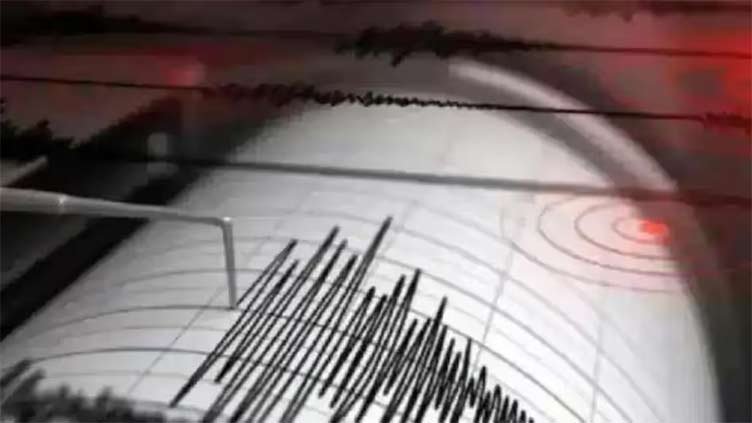4.9 Magnitude Earthquake Jolts Gwadar and Nearby Balochistan Areas – No Casualties Reported
On June 14, 2025, a moderate earthquake with a magnitude of 4.9 struck the coastal city of Gwadar and its surrounding areas in Balochistan, Pakistan. Although the tremor caused brief panic among residents, it fortunately resulted in no injuries or property damage, according to initial reports from local authorities.
Epicentre and Seismic Data
The National Seismic Monitoring Centre (NSMC) in Islamabad confirmed that the epicentre of the earthquake was located approximately 40 kilometers southwest of Pasni, a small coastal town in the Gwadar District. The quake occurred at a shallow depth of 14 kilometers beneath the earth’s surface, making it more likely for tremors to be felt over a wider area.
Tremors were reported in Gwadar, Pasni, Ormara, and parts of Turbat, with some residents also feeling mild shaking in Makran coastal belt areas. Though the magnitude was considered moderate, the shallow depth of the earthquake resulted in noticeable ground movement in nearby towns.
Panic Among Locals But No Damage
Residents in Gwadar and Pasni rushed out of their homes and buildings when the earth started shaking. Many people took to the streets, fearing that a stronger quake might follow. However, local disaster management authorities quickly issued statements assuring the public that there were no reports of casualties or structural damage. Emergency response teams were placed on high alert as a precautionary measure.
According to eyewitness accounts, the earthquake struck suddenly and without warning, causing windows to rattle and ceiling fans to shake. “We were sitting inside when everything started shaking. We immediately ran outside,” said a resident of Pasni. “Thankfully, it didn’t last long.”
A Pattern of Frequent Seismic Activity
This recent quake is part of a growing pattern of seismic activity in Pakistan in recent weeks. Similar tremors have been reported not only in Balochistan but also in Karachi, Peshawar, and Gilgit-Baltistan, raising concerns among experts and local communities.
Pakistan sits on the boundary of the Indian and Eurasian tectonic plates, a region known as a seismically active zone. Movements along this fault line regularly result in earthquakes of varying magnitudes. According to geological experts, the plates beneath the region are constantly in motion. When stress builds up along these fault lines, it eventually releases as seismic energy—causing earthquakes.
Internet Speed Issues to be Fixed in Few Days, PTCL
Read This Article
Why Are Earthquakes Common in Balochistan?
Balochistan, especially its southern coastal belt including Gwadar and Makran, lies in a highly seismic region. The Makran Subduction Zone, located off the Arabian Sea coast, is a key area where the Arabian Plate is subducting beneath the Eurasian Plate. This subduction zone is capable of producing large and potentially devastating earthquakes.
In fact, the region has a history of major seismic events. The most notable example is the 1945 Balochistan earthquake and tsunami, which had a magnitude of 8.1 and resulted in hundreds of deaths along the Makran coast.
Geologists and seismologists frequently warn that this region could be the site of another large earthquake in the future. Though smaller quakes like the one on June 14 may help release some pressure, they don’t eliminate the risk of a major seismic event.
National and Regional Monitoring
The Pakistan Meteorological Department (PMD) and the NSMC continue to closely monitor seismic activity across the country. Over the past few months, they’ve recorded dozens of minor to moderate earthquakes, which they attribute to ongoing tectonic movements. The PMD maintains real-time monitoring stations across Pakistan to ensure accurate detection and reporting of any seismic activity.
Following the recent Gwadar quake, the PMD reiterated the need for continued vigilance and better public education on earthquake preparedness. They emphasized that awareness is key to reducing casualties during such natural events.
Growing Risk for Coastal Infrastructure
The earthquake has once again sparked discussions around the vulnerability of infrastructure in coastal Balochistan, especially in Gwadar. With large-scale projects like the Gwadar Port, Gwadar Free Zone, and other CPEC-related developments ongoing, experts believe there is a need for stricter building codes and risk assessments.
Structural engineers and environmentalists have long called for earthquake-resistant construction in Balochistan’s seismic zones. Many buildings in remote towns like Pasni and Ormara are still made of mud or poorly reinforced concrete, making them more likely to collapse in the event of a strong quake.
While new projects under China-Pakistan Economic Corridor (CPEC) are reportedly built with seismic safety in mind, older structures and densely populated neighborhoods remain vulnerable.
Expert Opinions
Dr. Muhammad Tahir, Seismologist at PMD:
“The 4.9 magnitude earthquake near Gwadar is not unusual. This region sits on one of the most active tectonic boundaries. We have to understand that earthquakes will continue to occur—it’s the preparation and awareness that matter most.”
Dr. Nazish Rehman, Geology Professor at Quaid-e-Azam University:
“While this particular quake didn’t cause damage, it’s a stark reminder that a major event could strike anytime. Urban planning and disaster preparedness must be prioritized, especially in high-risk zones like Balochistan.”
Government Response and Preparedness Measures
After the earthquake, local and provincial disaster management authorities conducted rapid assessments to ensure no structural damage had gone unnoticed. Rescue and emergency services were directed to remain on standby, and hospitals were alerted in case of aftershocks.
The Balochistan Provincial Disaster Management Authority (PDMA) issued general safety guidelines and urged the public not to panic. People were advised to avoid sharing unverified information on social media and instead follow official updates.
However, experts believe that preparedness on the ground is still lacking. Despite regular earthquakes in the region, earthquake drills, public training programs, and early warning systems are not widely implemented. There is a growing demand for the installation of siren-based alert systems in major cities like Gwadar, Quetta, and Turbat.
Earthquake Preparedness Tips for the Public
While natural disasters cannot be stopped, lives can be saved through proper awareness and emergency planning. Authorities recommend the following safety measures during an earthquake:
-
Stay calm and do not panic.
-
Drop, cover, and hold on — Get under a sturdy piece of furniture and protect your head.Magnitude
-
If inside, stay away from windows, mirrors, and heavy objects.
-
Do not use elevators.Magnitude
-
If outdoors, move to an open area away from buildings, trees, and power lines.
-
Keep a disaster kit ready with essentials like water, food, flashlight, first aid, and documents.
-
Have a family emergency communication plan in place.
The Importance of Building Resilience
Experts agree that long-term disaster resilience will require more than just response mechanisms. It demands a strategic shift in how cities and towns are planned and constructed, particularly in earthquake-prone areas like Balochistan.Magnitude
This includes:
-
Strict enforcement of earthquake-resistant building codes.
-
Retrofitting old buildings to meet safety standards.
-
Investment in early warning systems.
-
Regular public drills and educational campaigns.
-
Strengthening coordination between federal, provincial, and district disaster authorities.
Looking Ahead: A Wake-Up Call
The June 14 earthquake might not have been destructive, but it is a timely reminder of the ever-present risk faced by Pakistan’s seismic zones. With urbanization on the rise and large-scale infrastructure projects underway in Balochistan, it is more important than ever to ensure that the region is ready to face any future disasters.Magnitude
Many experts argue that the recent frequency of minor earthquakes could be nature’s way of signaling that larger tectonic events are building up. While not every small tremor is a warning of a bigger quake, it highlights the need to prepare, educate, and build smartly.Magnitude
Conclusion
The 4.9 magnitude earthquake that struck Gwadar and nearby areas of Balochistan on June 14 may not have caused damage or casualties, but it has reignited discussions around earthquake preparedness in Pakistan. As a nation located on a major tectonic fault line, Pakistan must continue to invest in monitoring, infrastructure safety, public awareness, and emergency response systems.Magnitude
Earthquakes may be inevitable—but with the right precautions, their impact does not have to be catastrophic. The time to act is now, before a stronger and more dangerous quake hits.




